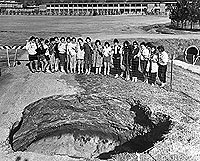Water: Karst
Windows into the truth
Millions of gallons a day of fresh water pouring out of holes in the ground, fresh water bubbling up into salt water, rivers that disappear only to pop up again a mile or more downstream - what kind of science fiction landscape is this?
It's karst, a kind of landform where the underground rock is easily dissolved by water. The word comes from a region in Slovenia called Kras that is famous for its caves.
 Students get a sinking feeling on the Florida State University campus, 1962 (photo courtesy Florida Photographic Archives) |
In the ARROW region are two karst areas, one in central and eastern Wakulla County and one in northern Jackson County. There's practically no barrier between the top of the land and the water-bearing rock below. The connection between the land surface and the aquifer is direct. It's why Chad Taylor of Jackson County calls karst features "windows into the truth."
Note: The content of the website has not been updated since 2005. The site remains online for it's value as legacy content and is unlikely to be updated.